One of my all-time favorite foods is bread, but like many of our favorite foods, not always the best for us when it comes to our health – especially what’s available as our options today. As most of us know, most all bread is a processed food-like product, it’s not real food (we don’t find slices of bread hanging from plants or trees, right?). It’s man-made. And our man-made options for a quality bread today are few and far between. When I do have it, its always on my reward day (I’ll always have bread in my Italian DNA for the occasional indulgence) where my body can handle the nutritional stress processed bread provides; as most bread we find in the grocery store today uses highly refined flour, is heated and nearly, if not totally, void of vitamins, minerals & enzymes – or dead food.
In fact, do you know why we see on many brand name grain/bread packaging (as well as milk) the words “Good Source of”, “Fortified” and “Enriched”? Usually with Calcium, Vitamin A, D, E, etc. attached to it…
Nutshell: It’s because these critical vitamins & minerals for healthy body/cell function are destroyed during the refining process (even though these phrases on packaging may look like something “extra special” for the food, triggering us to buy [clever deceptive Big Food], they’re not, it’s because it’s dead). They figured this out in World War II when over 50% of the soldiers enlisting for the war did not pass a physical for health. The government was stumped and wondering why so many people could be so malnourished and in poor health. Besides poor soil quality from conventional farming practices soil scientists realized and pleaded with congress about in 1936, the malnutrition was traced back to the early 1900’s when processing of food (including pasteurization) became prominent pre-World War I. Processing and canning of foods was a solution THEN for the war so we could ship foods in mass quantity across seas. WWI was our first major war where we sent millions and millions of troops across seas, whereas before that, major wars were fought on the homeland where we lived and our food supply was more readily available for soldiers. Processing and canning of food THEN was a solution for foods not spoiling and lasting longer periods of time so they can be shipped across the world – it was a solution to feed millions of soldiers. Yet they didn’t realize and figure out until the 40’s that the processing of the food decades earlier destroyed much of the nutrition in it, literally giving us soldiers that were so malnourished, they were turned away from enlisting in World War II.
As a result since the 1940’s, foods began to be “fortified” and “enriched” with cheap synthetic (not from nature) lab-made vitamins and minerals, and they still are even to this day. Why? Because the food is enzyme, vitamin & mineral nutrient-dead. You’re eating dead food… and what do we get when we chronically eat dead, processed food? We get chronically ill, diseased & eventually, dead people. You are what you eat.
Grain, and the bread made with it, back in ancient times used to be stone-ground (actual big ol’ stones), much of it sprouted, and some varieties were even made through a fermentation process (sourdough for example). Bread was minimally processed and it actually had some healthy qualities to it (in terms of nutrition still being intact) that many of our ancestors in different parts of the world relied on as a nutrient source. The highly refined grain bread we mostly find on grocery store shelves today is nothing like it; especially the non-organic stuff from poorly grown, nutrient-depleted grain (from nutrient-depleted soil). It’s what I call C.R.A.P. – Chemically Raised/Grown Agriculture Product… it’s a food-like product disguised as food and designed as a food industry for-profit staple… not for-health.
But what if we could make a raw, 100% real food bread with it’s enzymes and nutrients intact?
A raw bread we could use for one of those All-American meals: the sandwich?
A raw bread that doesn’t fall apart and slices great? (my goal for this recipe!)
A raw bread that is recipe-friendly:
- paleo*
- vegetarian & vegan
- gluten-free
- dairy-free
- egg-free
- ReBoot Protocol (week 2+)
and made with real food ingredients?
Is it possible while still tasting good?!
I give you the latest NYCT real food remix recipe for homemade raw “low-baked” bread…and probably one of my favorite real food remix recipes on this blog to date.
Nutrition Notes:
This raw bread has specific ingredients that have anti-fungal properties (great for anti-fungal protocols & diets), helps with peristalsis and cleansing the gut & colon, can be added to parasite-infection protocols, hypothyroid protocols, IBS protocols, and more (visit the online clinic or use the Ask Jon section to view partial lists and/or inquire about specific protocols NYCT provides). It also has omega-3 fats, iodine & vitamin B6 (a nutrient that is depleted in many individuals, especially women on or that have been on birth control). Although I’ll note, if you have impaired gut and digestive function, please first see my Kitchen Notes below (including notes on Paleo).
Ingredients
1 1/4 cup unpasteurized raw almonds, soaked minimum 4 hours in water (will plump up close to 2 cups)
7 medjool dates, pitted
4 tablespoon flaxseed (can sub: flax meal)*
4 tablespoon psyllium husk (can sub: psyllium seed powder)*
4 tablespoon dulse flakes
2 tablespoon chia seeds*
1/2 cup onion, chopped
3 garlic cloves
6 sun dried tomatoes (dry, not in olive oil)
Zest of 1 lemon (about 1 tablespoon)
1 teaspoon pink salt
1 teaspoon Italian seasoning
links above are brands I personally use and recommend nutrition you can trust
recipe updated 10-24-2014
Directions & Kitchen Notes below
[Be sure to see my Paleo* thoughts on starred ingredients above]
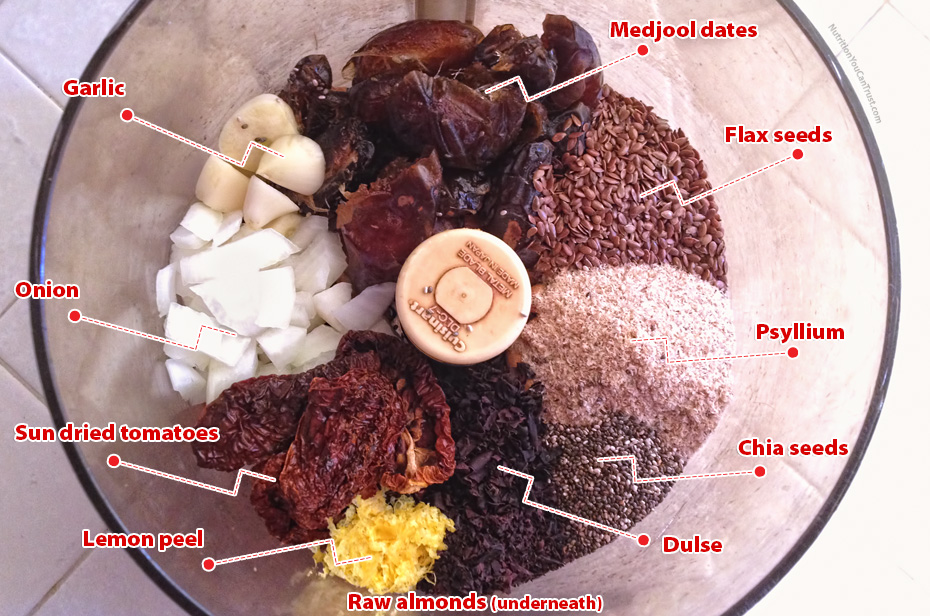 Ingredients pre-mixed in food processor
Ingredients pre-mixed in food processor
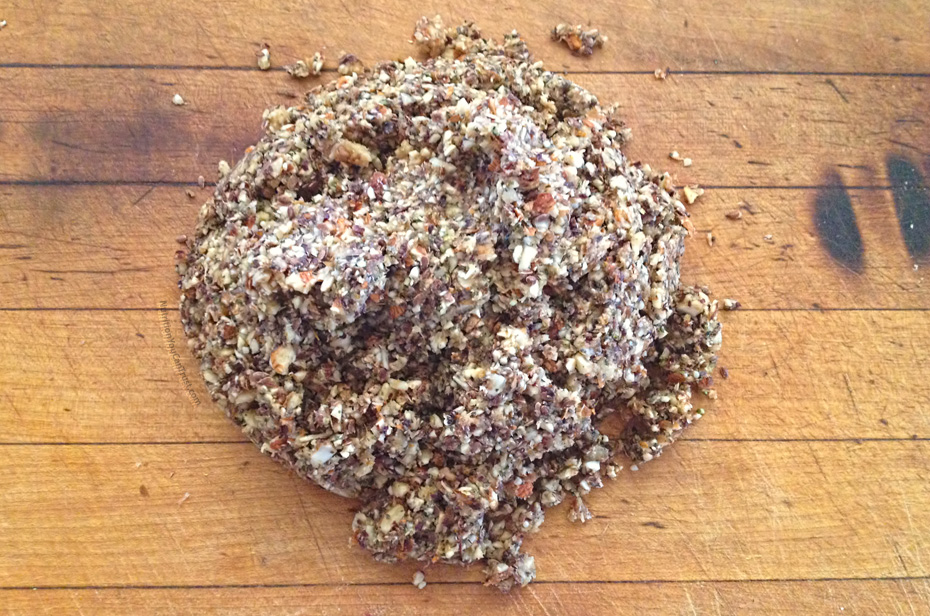 Ingredients mixed: pre-forming into shape
Ingredients mixed: pre-forming into shape
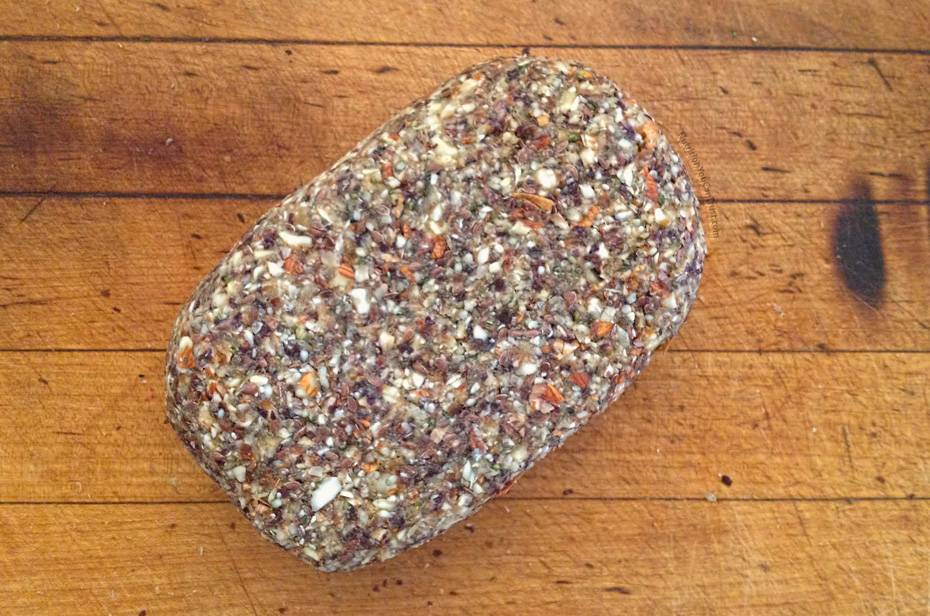 Ingredients formed into bread shape
Ingredients formed into bread shape
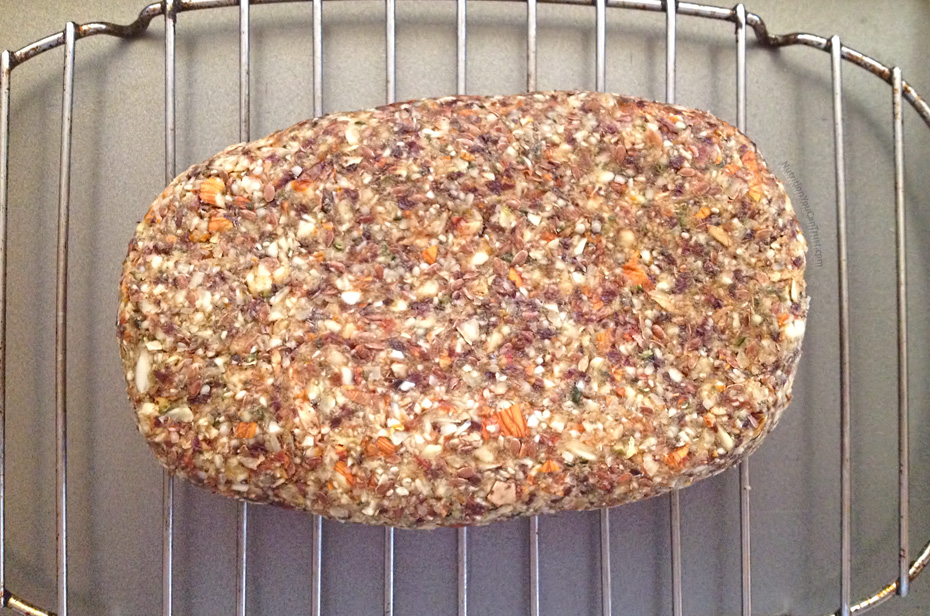 Pre-oven: Baking sheet with a rack for ventilation
Pre-oven: Baking sheet with a rack for ventilation
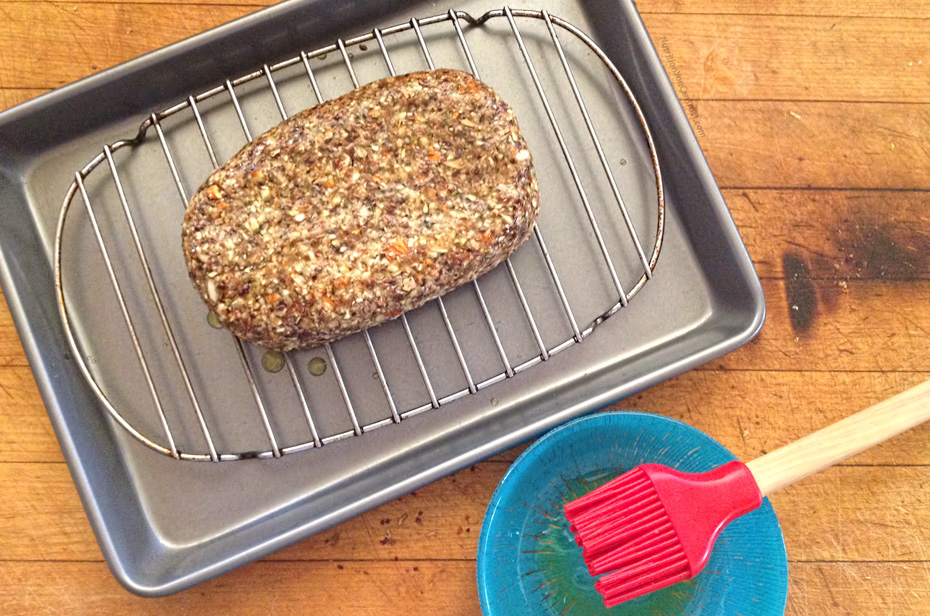 Pre-oven: Brush lightly all over with olive oil to prevent cracking
Pre-oven: Brush lightly all over with olive oil to prevent cracking
Click here to Pin this!
Directions
1. After raw almonds have soaked for a minimum of 4 hours, drain, rinse and dry very well.
2. Add all ingredients to a food processor and blend until everything incorporated. You may need to start and stop a few times and scrape down the sides with a spatula.
3. Pour the mixture onto a cutting board and begin pressing it all together in a big ball (like a big dough ball you would flip on different sides and knead). Press and flip on multiple sides over and over until the mixture is nice and compact (you really want it compact or it can crack).
4. Once all the ingredients are compact, form into the shape of bread loaf you want.
5. Add the loaf to a baking sheet with a rack so the bread can ventilate underneath.
6. Lightly brush the bread with olive oil to further help prevent cracking.
7. Place the tray in the oven at 115F degrees* see my kitchen notes on temperature below.
We’re going to “low-bake” it for 15 hours, essentially turning our oven into a food dehydrator.
Once it’s done, remove from the oven and indulge!
I always use a serrated knife or really sharp non-serrated to cut it. You can slice it as thin as sandwich bread or thicker like dinner bread (see images below). I’ll note however, this bread is dense and filling. Typically when I eat as a sandwich I go open face.
[Update 10-26: see my super thin cracker slicing and adapting of this recipe for raw crackers at bottom of post]
I like to keep it in the fridge for storage.
Kitchen Notes:
*Paleo: These can be some grey area ingredients in the paleo world meaning there isn’t a 100% definitive YES or NO (like dairy or grain would be). If you’re strict hunter-gatherer meat and veggie paleo eater, this recipe probably isn’t for you as I would categorize it more as a “modern paleo” recipe.
- Flaxseed: not too frowned upon by some of the leaders in the paleo/primal world-
- Mark Sisson: “I don’t consider it an essential part of anyone’s diet, but I’m leaning toward it being generally safe in moderation. If you’re a vegetarian or unable to get your hands on animal sources of Omega 3 fatty acids, a seed like flax might be a decent option, but for this grass-fed-meat-eating, fish-oil-swilling, antioxidant-rich-vegetable chomping audience, I don’t see why flax needs to be part of the dietary equation.”
- Robb Wolf: “I’d never really had problem with flax seed, the usage of flax seeds because the amount of omega 3s that you get from that are small and if you just handle them properly like grind them fresh, use them immediately, don’t cook with the stuff then you should be good to go.”
- Psyllium: Some prefer seed powder vs. husk. Psyllium seed powder is mostly a soluble pre-biotic fiber that ferments and can feed your gut flora. Psyllium husk is more of a bulking agent to keep the “train” moving along.
- Chia seed: These are typically not frowned upon, main remarks I see are about moderation. Don’t crush them by the spoonfuls at every meal. Ancient cultures loved chia seeds and it can be a healthy nutrient source for some people.
So… is it paleo or not?
My thoughts: To each their own. What I mean by that is, we’re all biochemically unique and have different physiological loads (stresses: nutritional, chemical, emotional, etc.) that must be addressed. For example, let’s say we have person #1 who is paleo and person #2 who is paleo, yet person #1 has impaired gut function and #2 doesn’t. They’re both paleo, but one has healthy digestive mechanics and one may not. To each their own…make sense?
If you have impaired gut function and know some of these ingredients may cause you problems, then if I was consulting with you face to face I would be cautious with eating this bread as flax, chia and psyllium could be a potential stress to the gut. I don’t know that unless I’m working with you personally, or you ask me…this is a blog, so I try to provide the best blanket answer with linked research, thoughts from other experts, etc…and I’ll add, blanket answers are never ideal when it comes to health in general (unless we’re talking a common denominator like food source), again because we’re all biochemically as unique as our finger prints.
That said, if you have a healthy functioning gut and know these ingredients won’t cause adverse reaction, go for it. The bread isn’t designed to eat the whole loaf, but a complimentary slice with a meal…if you do eat the whole loaf, you’ll probably be sitting on the toilet for a few hours. Don’t do it. Have a slice.
And I’ll also add, this bread is mainly designed to be real food ingredient “remixed” from the processed, dead food ingredient breads we see in our grocery stores. I would recommend this raw bread over the alternative highly processed C.R.A.P. (Conventionally Raised/Grown Agriculture [food-like] Product) Big Food breads we find that are, for lack of a better word, dead food.
As for moderation, this bread slices into about 20 pieces at roughly 1/4 inch slice. That means we’re getting:
- Psyllium: 1/5th of a tablespoon per serving
- Flax: 1/5th of a tablespoon per serving
- Chia: 1/10th of a tablespoon per serving
So can your gut handle that amount per slice? If so, go for it.. if not, don’t.
2. Temperature and “low-baking”: When we keep most all real food ingredients at ~120 F degrees or less temperature level, we keep them raw, enzyme-intact, and reduce loss of nutrients like vitamins & minerals. Some will argue no more than 105 F, some will say 120 F is too much. I don’t have a problem at 120, I do it.. but if you want to be safe with this recipe, you can easily put this in the oven at 115 F as well. I’ve actually done both temps. Works just fine. Next time I make it I’m going to try it at 105 F for a longer period of time…I’ll update this post with the results in this section. [Update 12-02: I made again at 105 F and let it go 24 hrs. Worked great]
- Temperature choices:
- 115 F for 15 hours
- 105 F for 24 hours
3. Maximizing time tip: here’s what I do to maximize my time… I’ll add the almonds to a bowl with water in the morning before I head out for the day. When I get home, I’ll drain and dry (this can be 8-12 hours later, which is OK for soaking almonds. 4 hours is minimum you want to do, but if you can do longer, even better!). Then I’ll make the bread in the early evening and add to the oven around 5pm, knowing that I’ll take it out of the oven 15 hours later at 8am the next day before I head out for the day. Overall point: adapt it to your schedule to maximize time.
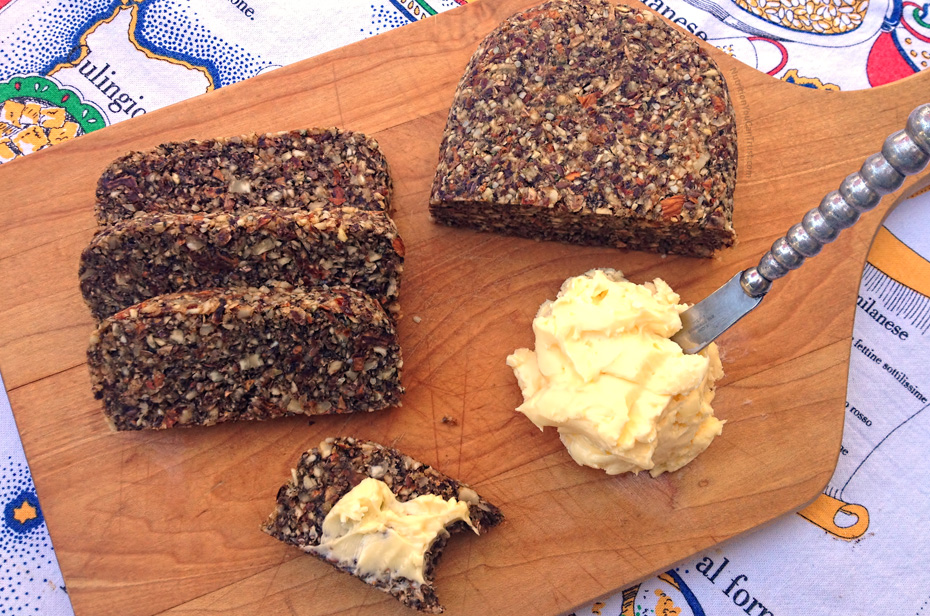 Raw bread with whipped raw butter
Raw bread with whipped raw butter
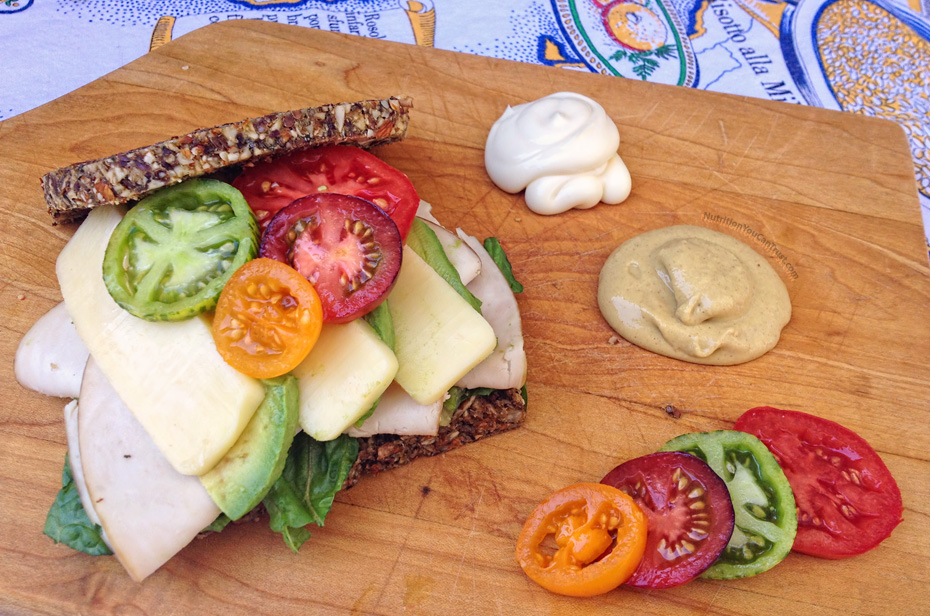 Real Food Sandwich: Pastured Turkey, Raw Cheese, Avocado, Lettuce, Tomato
Real Food Sandwich: Pastured Turkey, Raw Cheese, Avocado, Lettuce, Tomato
UPDATE [10-02-2014]: Here’s another paleo & ovo-vegetarian-friendly Egg Salad Sandwich using the raw bread I added to Instagram. Instead of mayo I used mashed avocado, roasted garlic, chili & more. Tasty!
Update [10-26-2014]: after posting the Certified Nutrition You Can Trust Lunchables post, here is how you adapt this raw bread recipe for crackers:
Step 1: Slice bread 1/8 – 1/4 inch (garden onions shown to help prop up angle to see)
Step 2: Slice bread into cracker size pieces and add to a tray like pictured
Finally, add the tray to the oven on 115 F degrees for another 4-5 hours. My suggestions is give them a test around the 3-4 hour mark and see how they’re doing. They’re not going to get rock hard crispy like a cracker, but they’ll turn into the firm texture of any raw cracker you would find at the store (see the Lunchables post for some recommended brands of raw crackers I like). I love making these on the weekend when I have my reward day: healthy crackers with some good raw cheese and vino al fresco. Perfecto.
Enjoy the healthy raw bread and crackers!


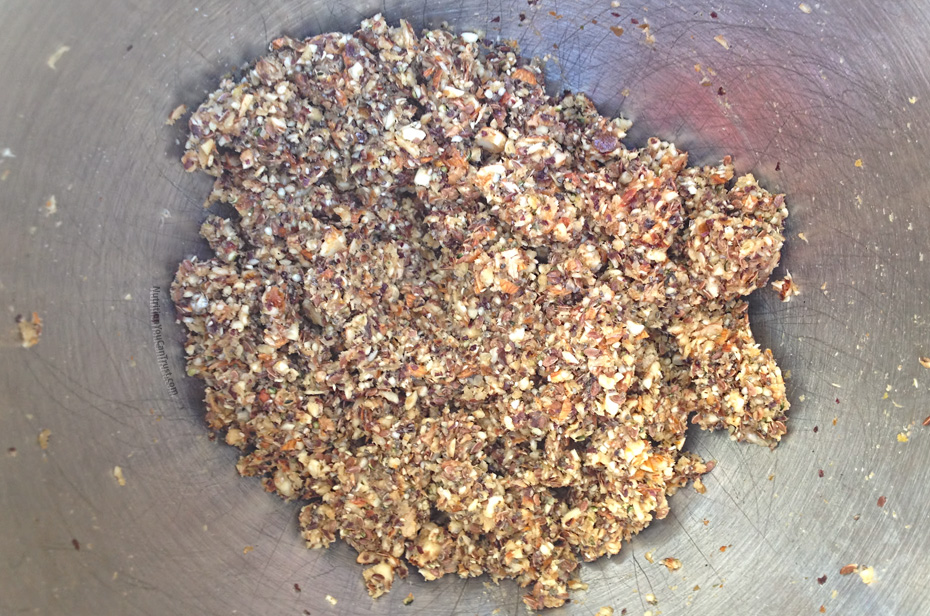
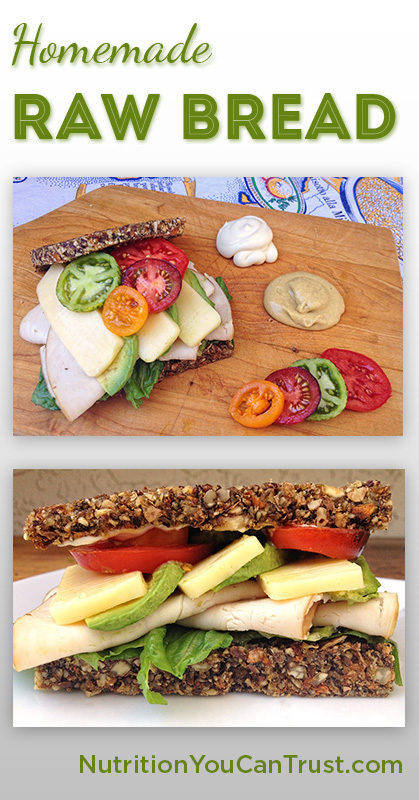
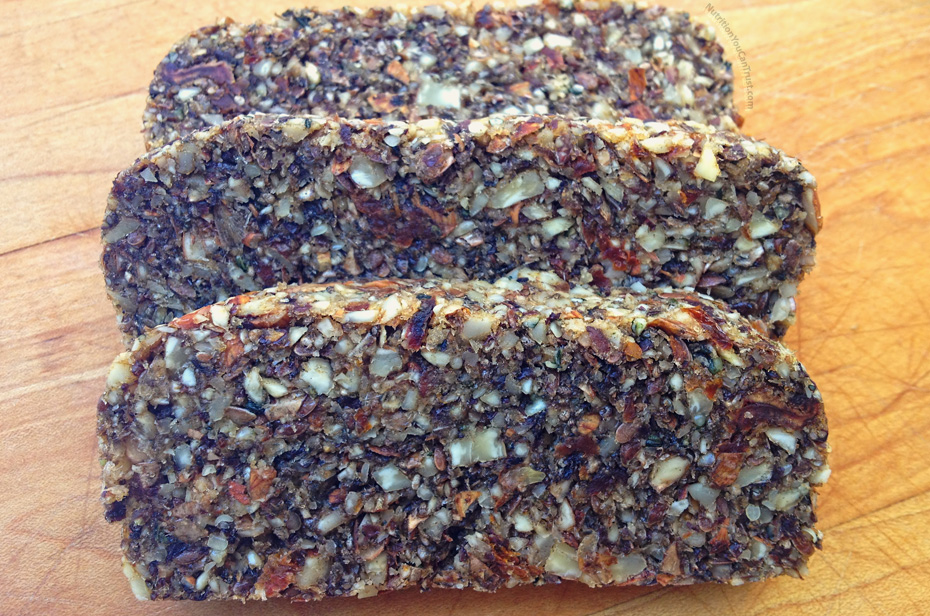
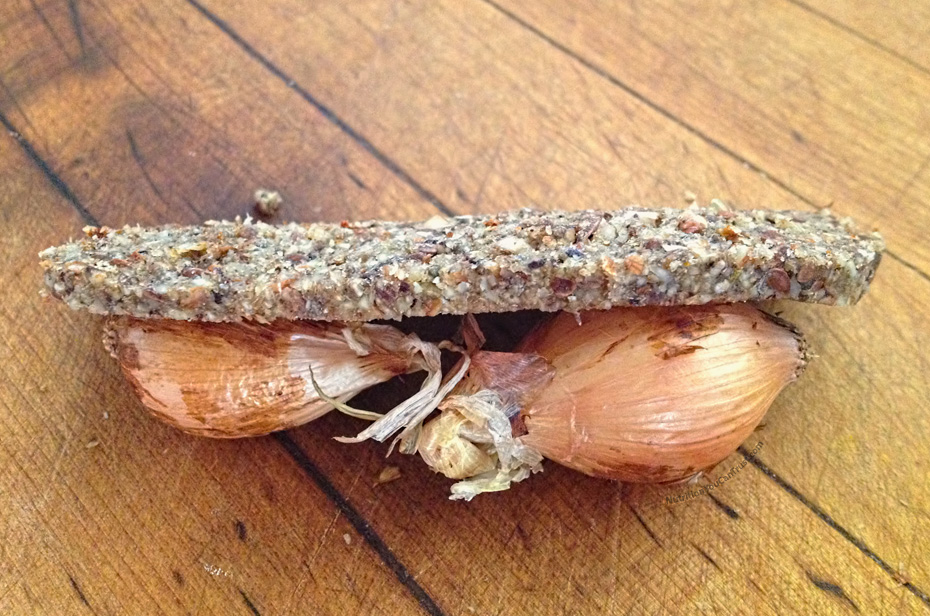
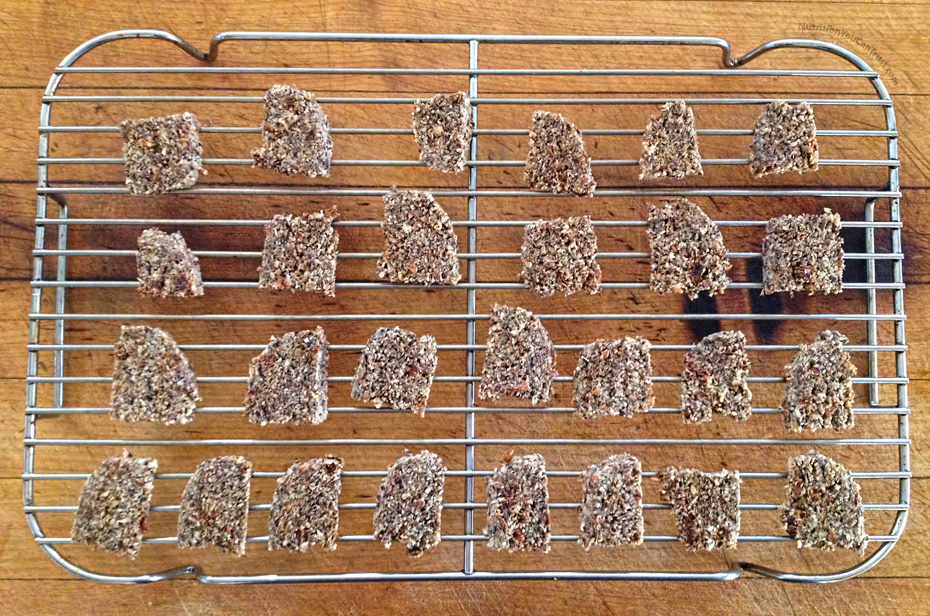







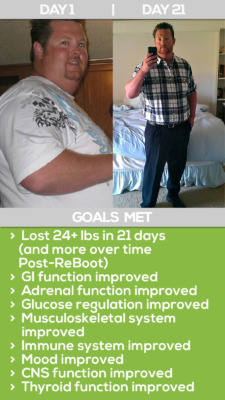




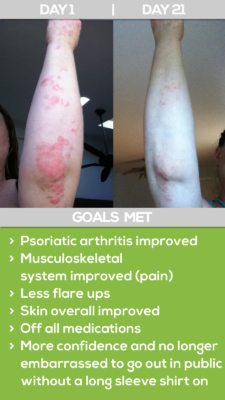



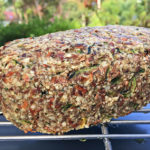



I am SO EXCITED to try this!
Excellent!
Well done Johnny. I’m going to be trying this for sandwiches.
Thanks Steve. Let me know how they turn out for you
So much great info! I love your posts Jon!
I appreciate it Natalie and glad you do. Cheers!
Ooh Yum! 🙂
This just went on my weekend To-do list. Thank you for sharing, it looks great :p
Awesome Heather! You’re quite welcome.
Hi Jon! I just discovered this recipe on Pinterest and was so excited to try it. I bought all the ingredients and was ready to make it, then I discovered my oven’s lowest temperature is 170 degrees. What is your suggestion for baking time? I’m disappointed that I’ll probably be Cooking all the enzymes and healthy vitamins out. Thanks for your help!
Hi Lori, glad you found it! hmm cook time at 170.. If I were in your shoes I would probably do it 3-4 hours, but I would likely check it each hour since we’re testing a temp/time.. Do you have enough ingredients for making two loaves? Whenever I’m testing temperatures I usually make double or triple the recipe so I can see what temps work best. For example with this and testing at 170, I would make at least two loaves, and one of them would be my “test” loaf.. so at 1 hour mark I might slice into the center of it and see how it looks..2 hours, check it again.. 3 hours.. and so on until I find that right time/temp sweet spot.
Hope this helps.. let me know if you have any other questions, and most importantly, how it turns out!
Thank you so much! I believe I have enough ingredients for two loaves, so I will try it out! Thank you for getting back to me so quickly!
Hey there!! Do you have a suggestion for substituting the sundries tomatoes?? I have a tomato allergy but I would love to give this bread a try. Thanks a bunch!
Hey Summer, you could probably just leave them out and be fine.. have you seen the raw olive bread version of this? That could be another option you can try. That stuff is good if you like olive bread!
here’s the post: https://nutritionyoucantrust.mystagingwebsite.com/raw-olive-bread/
I too have a tomato sensitivity and was going to ask. Have you tried making this bread without tomato or substituting a different ingredient? Does anyone else have a opinion?
Awesome recipe! I’m from Brazil and here we can’t find dulse flakes, its possible make this bread without it? Thank you…
Hi Patricia, you could leave them out. They’re not a deal breaker.
Hi Jon, this looks delicious! I’m just wondering, how long will this last in the fridge and would it freeze ok? Thanks a lot 🙂
Hi Carina, I’ve kept it in the fridge for up to a week… but to be honest, it’s usually gone before that 🙂
Looks amazing! Would I be able to cook the bread at a higher temperature for a shorter period of time?
Hi Alexis, thank you! Technically you can, but it’s best you don’t. Main reason being: we’re working with heat sensitive ingredients like flax and chia. They can denature very easily and then we’re ingesting and assimilating those rancid fats in the body. Best to keep it lower temps.
The lowest setting on my oven is 150 F…. How long would you suggest cooking at 150 F?
Hi Donna, see the comment above from Lori and my response in regards to checking it. She was at 170F and I suggested 3-4 hours. Maybe for you at 150F try around 4-5 hours with checking it like I mentioned. Hope that helps you.. enjoy!
How would I use a dehydrator to make this? It looks amazing!
Hi, this recipe looks amazing. How long would you dehydrate this loaf for, please?
Hi, can I use a dehydrator instead of the oven?